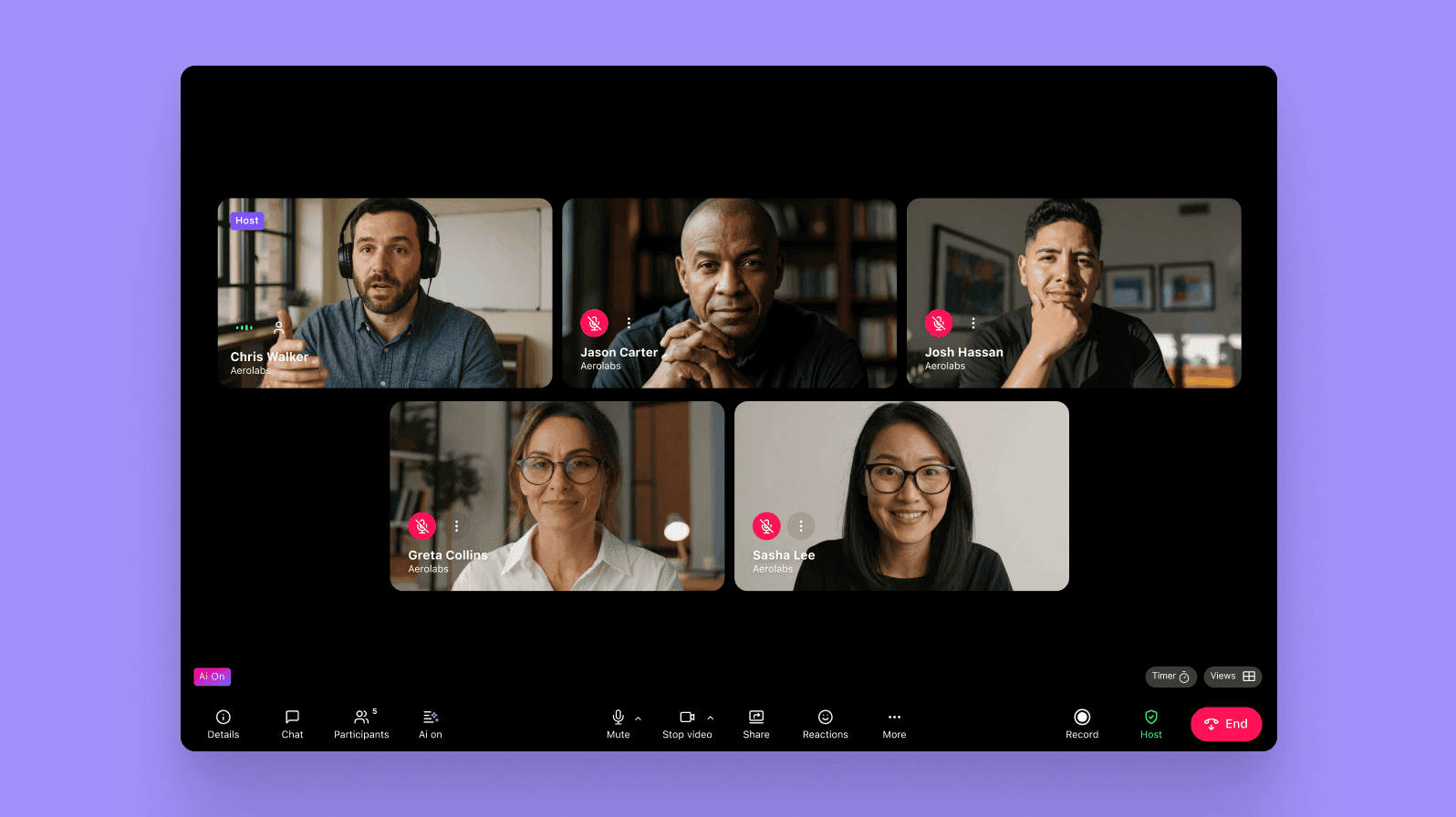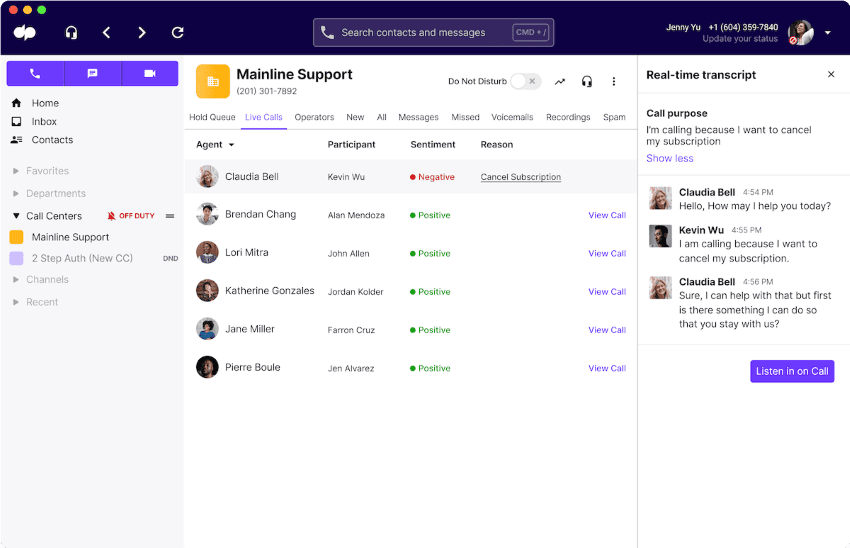Enterprise Collaboration: Definition, Systems & Tips | Dialpad

Senior Content Marketing Manager

Tags
Share
The famous saying that “there’s no I in team” holds even more true than usual where enterprises are concerned. These large companies thrive thanks to the hard work and collaborative power of their many employees.
After all, effective teamwork ensures that enterprises are even greater than the sum of their parts.
The question, then, becomes how can you optimise enterprise collaboration so that your own company can reap all the associated benefits. Let’s explore, beginning with a look into the nature of enterprise collaboration.
What is enterprise collaboration?
An enterprise is a large, often multinational company. Enterprise collaboration refers to having multiple people or teams across these kinds of businesses work together, either to help one another or to work towards a common goal.
Enterprise collaborations may involve both in-office and remote teams, as well as employees across multiple regions. This makes it much more complicated to coordinate seamless teamwork.
In a small business, your employees may also be familiar with each other. That goes doubly if your business only has one or two teams, which is not the case for enterprises. They simply have more employees to account for and cater to.
That’s why you’ll typically need an enterprise collaboration strategy as part of your approach to this type of teamwork; we’ll examine these shortly.
What are the typical challenges of enterprise collaboration?
We’ve mentioned that collaboration for enterprise work can often be harder to get right than small business collaboration. Here are some of the concrete reasons why that’s the case:
Schedule coordination
Drawing up a plan that works perfectly with ten or so schedules is a difficult, yet manageable, task. Doing the same for a group of over 100 is more than a little challenging. Particularly if that group contains people from lots of different departments.
The busier everyone’s schedules are, the harder it is to make enterprise collaboration work well. Fortunately, this is an example of something an enterprise collaboration tool can help you with. We’ll talk about these in more detail shortly.
Time differences
Small businesses tend to be based in a single location, with employees able to meet and work together in person or online. Enterprises, on the other hand, often have teams spread across multiple territories or even worldwide.
This creates complications in the form of time zones.
Scheduling a call at a convenient time for people in two different time zones is difficult. Trying to schedule one for people based in Australia, the UK, China, and Canada is exponentially more difficult.
👉 Dialpad tip:
If you’re looking to mitigate the effects of time differences, you’ll need tools that empower you to work asynchronously. Dialpad’s built-in transcription does this by creating an accurate transcript of any call or meeting. So, even those who couldn’t attend can get up to speed quickly.

Different work styles
Many people perform best when they take the time to draw up detailed plans first. Others are more skilled at improvising and being spontaneous. Still others struggle without a visual component or a written log that they can consult whenever they’d like.
Since enterprises consist of more people, this means that they’re also more likely to include employees with diverse work styles. This diversity is a wonderful asset in many ways, though it can certainly complicate the process of enterprise collaboration.
Different priorities
Say you were to gather 100 employees in a room. Then, you ask each of them to name the most important feature of a piece of enterprise live chat software. How many of them would be likely to agree?
In all likelihood, you would see at least 20 different ideas put forward, assuming many people do agree with one another. But what happens if we change that number to 1,000?
This simple example shows clearly that everyone tends to have different priorities. A fact that becomes clearer the more people get involved in a single activity. Culture, environment, personality, and more can factor into these differences, which can complicate the matter of enterprise collaboration.
Why do you need an enterprise collaboration strategy?
It’s essential to dedicate time to crafting a powerful collaboration strategy. An effective strategy can deliver the following worthwhile benefits:
Better organisation
The first, and perhaps the most important, reason for putting together a collaboration strategy also doubles as one of the top benefits of enterprise collaboration systems. This is improved organisation.
When you know exactly when each deadline is, you can easily plan when to complete your relevant workflows. A strong strategy clarifies deadlines, and a great enterprise collaboration tool lets you see those deadlines at any time.
Good organisation also helps teams work out problems on the go without slowing down. This ensures any collaboration stays on track regardless of unexpected challenges.
With Dialpad, for instance, employees can communicate freely by live chat or call from the same place:

Easier compromises
Enterprise communication and collaboration are not always easy, especially when lots of people are involved in the conversations. This is where a strategy can help your teams work as optimally as possible.
Drawing up a detailed strategy before starting any collaborative work helps to work out compromises ahead of time. This sets clearer expectations and lets everyone know what will be expected of them.
These expectations can then also form the basis of future compromises.
Let’s say, for example, that one group really dislikes morning meetings. However, they will be collaborating with another group that’s based in another country. Both groups have already established in the strategy that they’ll be doing weekly check-ins to catch up and see how everyone has progressed on the collaboration.
If the only time the second group is available falls in the morning for the first, the afternoon people will know ahead of time that they will need to compromise. This will be happening as per their own agreement and strategy, making the compromise more palatable to them.
Improved teamwork
When everyone knows exactly what the plan is, as well as what their role looks like within that plan, they’ll be able to work together as a unit more efficiently. This is because any one employee can check what their role is and how it relates to those of their teammates.
For example, let’s say you’re assigned to complete a specific workflow within an enterprise collaboration project. If you find yourself wondering what sort of impact your work will have on the final outcome, you can consult the strategy document.
There, you will clearly see that your workflow helps your manager gather the information they need to deliver an important presentation to a group head. This reminder then motivates you to work efficiently so the presentation can go as smoothly as possible.
Documentation
An enterprise communication solution lets your teams keep all their communications unified in a single place. Similarly, an enterprise collaboration strategy works as a centralised space to store your complete plan.
Good documentation makes it easy to look back and see when something was said or decided. It helps you pinpoint stronger and weaker points, which lets you make improvements in future projects. In other words, documentation paves the way for future success.

How enterprise collaboration systems can help
Next, we’ll be considering some of the best examples of enterprise collaboration systems that help your teams and employees work together more effectively. But, just what do we mean by a “collaboration system”?
What are enterprise collaboration systems?
Simply put, enterprise collaboration tools or systems are platforms designed to help facilitate group work in large companies.
Great enterprise collaboration platforms are more than just places to log progress. Instead, they tend to be virtual spaces that come with plenty of features to support collaborative work of all kinds.
Let’s look at what that means in practice, with some examples of enterprise collaboration systems. This is a non-exhaustive list, but the types we’ll be looking at are the most broadly useful.
Project management tools
Our first enterprise collaboration systems example is that of a project management tool.
These are designed to make the task of managing projects as simple as possible. They work by providing managers and workers access to all the information they need quickly and easily.
Project management tools also get rid of the uncertainty that comes from being unsure about where the scope of your role in a collaboration lies. In other words, they make things clearer for teammates trying to determine what they need to do.
These tools further help project leaders get in touch with employees who are struggling to complete tasks or collaborate with the team. This leads to smoother communications and better overall collaboration.
File sharing systems
The days of having to cover your entire desk in printed pieces of paper are behind us in today’s modern work environment. This does not, however, mean that the documents themselves are going out of style; far from it, in fact.
Documents can simply be shared in a more efficient manner now.
Instead of having to photocopy and re-print documents many times over, you can streamline enterprise collaboration by having everyone use dedicated file-sharing systems. These virtual spaces let users upload and download files easily, in a single easily-accessible location.
This is particularly useful for collaborations that rely heavily on getting lots of work done in shorter time frames.
Unified communications or collaboration software
In terms of virtual solutions to improve your enterprise collaboration, there are few that can surpass unified communication and collaboration tools.
These bring together all forms of communications, from texts to video calls to phone calls and beyond, into a single platform, which also lets you share files and create documents.
The best solutions also incorporate AI technology to give you the best possible experience. This transforms them into an AI-powered collaboration platform perfect for communicating and working with anyone, anywhere.
Furthermore, collaboration platforms like Dialpad are also uniquely suited to helping leaders support their teams.
For instance, an enterprise might include a customer-facing contact centre team. Dialpad has a fully integrated contact centre platform, with real-time sentiment analysis:

Live sentiment analysis is an AI-powered feature that shows exactly which ongoing calls may be going awry. Managers or supervisors can then jump in to assist any colleagues who are in need of a little help.
So, in addition to being a virtual collaboration space, solutions like Dialpad are also great at helping you communicate and get (or give) proper support.
Other best practices for making enterprise collaboration second nature in your organisation
Lastly, let’s look at some best practices you can implement to make efficient collaboration a day-to-day part of your enterprise.
Practice in all areas
If enterprise collaboration is something that only happens for occasional cross-departmental projects, it will always make some employees nervous. This is because they won’t be familiar with the processes involved or the typical expectations associated with this type of collaboration.
On the other hand, if enterprise collaboration is written into the DNA of your company, your employees will find that it becomes second nature to them.
For example, consider your enterprise sales team. They should use the same enterprise collaboration system tools for workflows only involving sales employees as they would for joint projects with the marketing team. This helps the tools become a comfortable and familiar standard.
Educate everyone
Enterprises that want to encourage their staff to get comfortable with enterprise collaboration need to make sure that those staff members know exactly what to do.
Providing training on enterprise collaboration leads to better responses to manager or leader’s requests for those collaborations to happen. This is because employees will already be confident in how the tools work and what to do, reducing insecurity and frustration.
Centre teamwork in your ethos
Great collaborations typically rely on two main things: the right tools and the right kind of teamwork. This is why you’ll want to make sure that co-operative work is valued and encouraged in your enterprise.
You can start emphasising the importance of teamwork by encouraging employees to consult each other in their daily workflows. This helps foster an environment of trust, in which everyone talks to each other and feels comfortable working together.
Additionally, it helps to have teams schedule regular internal catch-ups, even if the members of those teams aren’t in the same place. This is a simple matter when you use tools like Dialpad, which empower remote workers.

Embrace diversity and inclusion
Enterprises that are based in multiple countries (or even continents) can easily form sub-groups based on location. While this promotes internal teamwork, it makes it much harder to encourage true cross-company collaboration, as people will only be used to working with others from similar countries.
This is where a diverse, inclusive company culture really shines.
By making sure your company is welcoming to people of all kinds, you can discourage “echo-chamber” style thinking. You can also promote the importance of listening to and understanding others with whom you may not have much in common, which leads to much more effective collaboration.
Be open to feedback
Your employees are a precious resource. Without them, there can be no enterprise collaboration, but with them, your collaborations can be stronger than ever.
Create spaces for employees to voice their thoughts on collaborations past and present. This ensures your employees are encouraged to think critically about the collaborations they’ve taken part in or seen.
It also helps show them that you want them to feel comfortable and happy in collaborative projects, and allows you to provide the support they need.
Better collaboration helps your enterprise thrive
At their core, enterprises are like sports teams. They work best when everyone is able to rely on one another, play to each other’s strengths, and work together towards mutual success.
This is why mastering enterprise collaboration helps your business be the best version of itself.
With dedicated enterprise collaboration software, alongside a well-crafted strategy, this becomes easier than ever. In other words, by giving your teams the tools they need to succeed, you can capitalise on their potential and see your business thrive.
Prioritise enterprise collaboration with Dialpad
See how your enterprise team can boost productivity with a unified communications solution. Book a demo of Dialpad, or take a self-guided interactive tour of the app!
